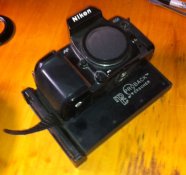Hmmm... some confusion in this thread.
Polaroid backs for most MF cameras are a different beast than for 35. The Forscher Probacks used a block of fiber optic material, about the size of the film plane, to transfer the image from the 35 film plane to the polaroid. (This sytem was also used for MF cameras like Mamiya rangefinders)
They're not intended to fill the whole frame, they're for proofing and testing lighting, generally on commercial shoots. Back in the film days, there were several types of polaroid pack film, but commercial shoots primarily used a 100-speed color to match the ubiquitous EPP Ektachrome and other 100-ish roll films. There was also an excellent 64T polaroid film in pack and 4x5. The color and speed was remarkably accurate, even coming through the fiber optic. You'd generally open up 1/2 to 1/3 stop (and of course you snip tested all your rolls for additional push or pull processing). The polaroids would be a very close match to your final film when it came from the lab. it was wonderful product.
Because the sheet size was so huge compared to the 35 frame, there was a small nylon "strap" sticking out of the back of the proback. When you shot a frame, you'd pull the tab of the polaroid out until it was even with the end of the strap (not far enough to crush the chemistry packet), and then could shoot another bracket. When you pulled the sheet from the back, it would crush the packet and then you developed the sheet normally and it would have 2 frames on the sheet - the strap was just a guide to allow getting 2 frames on one sheet. In those days, you kept a couple cheap loupes in your bag for viewing the 'roids, and many clients/art directors had their own on neck lanyards. When louped, the pack film images had a definite "texture" - they weren't fine-art style stuff (the B&W pos-neg was most definitely fine-art capable, but I never made prints from 35mm, only 6x7 and 4x5). But the highlights, shadow detail, and color rendering were very good for tweaking a shot in the pre-digital era.
(I once came across a set of magnetic picture frames for your fridge door that were for the tiny wallet-sized school pictures... I'd have my favorite images "framed" on the studio fridge - I had some really gorgeous shots for high-end retailers and apparel manufacturers, editorial, etc. Wish I still had 'em.)
Most shooters then didn't use a timer for the polaroid - after 30 seconds or so, you'd peel back a corner and check for solid black, and every ten seconds or so peel further until the unexposed edge had developed to solid black.
Because the pack-holder was even bigger than many 35 bodies, it also came with a machined post with tripod screws that would raise the whole camera up enough for the camera & pack combo to clear the tripod head. Most shooters kept a release plate on this. You would generally assign a body to polaroid duty, as getting the back on and off was very fiddly. At the end of the pro film era, cameras like the F4 (for Nikon) were popular commercial cameras for 35mm fashion, so cameras like the 8008s or N90s were popular for polaroid duty, since they were cheaper yet still went to 1/8000th, giving you all the speeds a modern film body might use on a shoot. Once you had a good 'roid and client signoff, you'd swap the lens from your roid camera, make sure the settings were good, adjust exposure per your experience with polaroid vs. film, and start shooting. You could spot a newbie by the time they'd spent changing the polaroid back for the film back - guys who could only afford one body.
When doing outdoor fashion, it was pretty common to see trash bags hanging from tripods - polaroid generated a lot of trash, it was covered in goopy chemistry that could stain clothing or irritate sensitive skin. The fiber-optic backs were expensive products - about $1200 in today's money, plus dedicating a modern body - so the workflow above wasn't so much weddings and portraits, but more shooting for big US brands, agencies, annual reports, and so on.
I still have a Forscher ProBack on an 8008... can't really part with it! Very cool bit of ingenuity.
More info
at this link.












